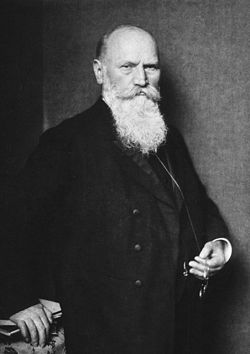Heinrich Wilhelm Gottfried von Waldeyer-Hartz
Heinrich Wilhelm Gottfried von Waldeyer-Hartz | |
|---|---|
 | |
| Born | 6 October 1836 |
| Died | 23 January 1921(aged 84) Berlin,Germany |
| Known for | consolidating theneuron theory, Naming the chromosome |
| Scientific career | |
| Fields | Anatomy,HistologyandPathology |
| Institutions | Center for Anatomy of the Charité1883–1917 |
Heinrich Wilhelm Gottfried von Waldeyer-Hartz(6 October 1836 – 23 January 1921) was a Germananatomist,known for summarizingneuron theory[1]and for naming thechromosome.[2]He is also remembered by anatomical structures of the human body which were named after him:Waldeyer's tonsillar ring[3](thelymphoid tissuering of thenaso-andoropharynx) and Waldeyer's glands (of the eyelids).[4]
Contribution to neuron theory
[edit]Waldeyer's name is associated inneurosciencewith the "neuron theory",and for coining the term"neuron"to describe the basic structural unit of thenervous system.[5]Waldeyer synthesized the discoveries byneuroanatomists[1](and laterNobel Prizewinners)Camillo Golgi(1843–1926) andSantiago Ramón y Cajal(1852–1934), who had used thesilver nitratemethod of staining nerve tissue (Golgi's method), to formulate widely cited reviews of the theory.[1]Waldeyer learnedSpanishin order to absorb Cajal's detailed studies using Golgi's method and became his friend, mentor and promoter in the German-dominated field of microscopic anatomy. The theory was published in a series of papers in the main medical journal of Germany,Deutsche Medizinische Wochenschrift,which became extremely influential. However, as Cajal points out, though Waldeyer "supported the theory with the prestige of his authority, he did not contribute a single personal observation. He limited himself to a short brilliant exposition of the objective proofs, adduced byHis,Kölliker,Retzius,van Gehuchtenand myself, and he invented the fortunate termneuron."[6]
Cytology and embryology
[edit]Waldeyer also studied thebasophilicstained filaments which had been found to be the main constituents ofchromatin,the material inside thecell nucleus,by his colleague ofKiel,Walther Flemming(1843–1905). Although its significance for genetics and for cell biology was still to be discovered, these filaments were known to be involved in the phenomenon ofcell divisiondiscovered by Flemming, namedmitosis.as well as inmeiosis.He coined in 1888 the term "chromosome" to describe them.[1][2]
Among his many other anatomical and embryological studies, Waldeyer became known for his pioneering research on the development ofteethandhair,many of the terms he invented are still in use today. He also published the first embryological, anatomical and functional studies about the naso-oro-pharyngeal lymphatic tissue, which received his name.
In 1904, he was elected as a member to theAmerican Philosophical Society.[7]
Bibliography
[edit]- Über Karyokinese und ihre Beziehungen zu den Befruchtungsvorgängen.Archiv für mikroskopische Anatomie und Entwicklungsmechanik,1888, 32: 1–122. Paper about mitosis and chromosomes.
- Ueber einige neuere Forschungen im Gebiete der Anatomie des Centralnervensystems.Deutsche medicinische Wochenschrift,Berlin, 1891: 17: 1213–1218, 1244–1246, 1287–1289, 1331–1332, 1350–1356. (About some new researches in the field of anatomy of the central nervous system). His most famous statement and summary of the neuron theory.
- W. von Waldeyer-Hartz:Lebenserinnerungen.Bonn, 1920; 2nd edition; Bonn, 1921; 3rd edition, 1922. His memoirs.
References and notes
[edit]- ^abcdScheuerlein H, Henschke F, Köckerling F (2017)."Wilhelm von Waldeyer-Hartz-A Great Forefather: His Contributions to Anatomy with Particular Attention to" His "Fascia".Front Surg.4:74.doi:10.3389/fsurg.2017.00074.PMC5723023.PMID29255713.
- ^abWinkelmann A (2007)."Wilhelm von Waldeyer-Hartz (1836-1921): an anatomist who left his mark".Clin Anat.20(3): 231–4.doi:10.1002/ca.20400.PMID17072873.S2CID39118426.
- ^Cremer T, Cremer C (1988)."Centennial of Wilhelm Waldeyer's introduction of the term" chromosome "in 1888".Cytogenet Cell Genet.48(2): 65–7.doi:10.1159/000132590.PMID3058399.
- ^A third structure, the sheath that encircles the terminalureter,is also occasionally named in his honour; it is then referred to asWaldeyer's sheath.
- ^Mehta, Arpan R.; Mehta, Puja R.; Anderson, Stephen P.; MacKinnon, Barbara L. H.; Compston, Alastair (2020-01-01)."Etymology and the neuron(e)".Brain.143(1): 374–379.doi:10.1093/brain/awz367.ISSN0006-8950.PMC6935745.PMID31844876.
- ^Cajal, S. Ramón y. (1954)Neuron theory or reticular theory: Objective evidence of the anatomical unity of nerve cells.Transl. MU Purkiss and CA Fox. Madrid:Consejo superior de investigaciones científicas.
- ^"APS Member History".search.amphilsoc.org.Retrieved2021-06-28.
External links
[edit]- Heinrich Wilhelm Gottfried Waldeyer-Hartz.WhoNamedIt.
- Short biography and bibliographyin the Virtual Laboratory of theMax Planck Institute for the History of Science
- 1836 births
- 1921 deaths
- German anatomists
- German neuroscientists
- Members of the Prussian House of Lords
- Scientists from the Duchy of Brunswick
- History of neuroscience
- Corresponding members of the Saint Petersburg Academy of Sciences
- Foreign associates of the National Academy of Sciences
- Academic staff of the University of Strasbourg
- Members of the American Philosophical Society
- Members of the Royal Society of Sciences in Uppsala
- Recipients of the Cothenius Medal
